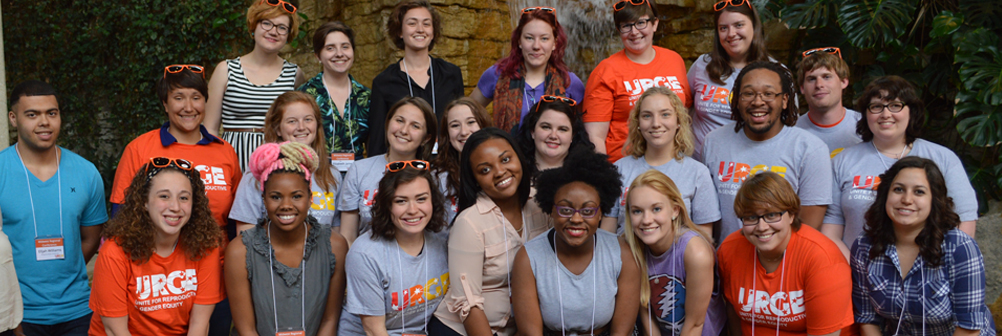Why Are We Queering Reproductive Justice Anyway?
Posted by Guest Blogger
June 10, 2013
This is my first Pride Month as an out, bisexual woman of color. I am a year and change into a journey that started as a conversation with my boss about feminism and racial identity and claiming space and movement building and somehow circled around to me…possibly…liking…girls. And while I had confessed to occasional crushes or attractions to a few close friends over the years, it wasn’t until March of 2012 that I actually said these words out loud to someone in the context of who I am and not a temporary feeling or state of mind.
The last year has been as exhilarating and terrifying and gratifying and painful as you’d expect. But as I told my friend Sarah over this past weekend, I don’t think I would have had the courage to come out if I hadn’t found my way to Choice USA, to Washington, DC, and to the reproductive justice movement. Because wow, there are a lot of LGBTQ people here. And they are doing amazing and inspiring work for access to comprehensive healthcare, including abortion care; for access to complete information and education about sex and sexuality for young people of all ages and orientations; and access to contraception and birth control. It’s true that the movement for reproductive health, rights and justice is primarily concerned with reproduction, and that straight women’s reproduction has been at the center in policy, analysis, and scholarship since the beginning. But queer people have always been part of this movement, even if their voices have been muted and experiences and perspectives less evident.
We at Choice USA conceived of a week of visibility during Pride Month because it’s an ongoing conversation in our office, at our happy hours and coalition meetings and among our friends. Why do the movements for reproductive equity and LGBTQ equality operate so separately when we share so many common interests and enemies? And if the movements are as separate as they appear from the outside (and the inside) then what the hell are all these queers doing in the “women’s” movement?
To be honest, I don’t know. I can’t speak to the unique analysis and personal experiences that led each person to the movement. That’s why we reached out to some of our smartest and most eloquent friends to share their thoughts in a series of blog posts on the subject of the intersection of these two movements.
Most of our authors are members of the fabled Millennial generation. This was important to us, because Choice USA is a youth-led and youth-directed organization. While we are privileged to work with Boomers and Gen Xers on our staff, board and in the movement, we have made it our mission to give a platform to voices and perspectives of young people who are taking the movement in a new direction.
One of the coolest parts of my job as Program Director at Choice USA is training young activists in the skills and analysis they need to bring change to their communities. We start with the basics: justice, oppression, intersectionality. This is one of my favorite concepts to break down because it sounds so academic until you think about what it really means. The definition we use is: The complete person’s life experiences, based on their perspectives and the way they have been perceived and treated. In other words: It’s about who we are. How we see ourselves, what we know we need, and how others see us and the assumptions they make based on their perceptions. When you stop thinking about intersectionality as a concept and start thinking about how it applies to your life – the body you inhabit, the way you see the world, and the space from which you begin your fight for justice, it stops feeling so academic. Intersectionality is all of the identities we hold, and none of us, ever, enters a room or a conversation without every single part of who we are – every privilege, every oppression, every experience. And once you understand that, it’s only a tiny analytic step to recognizing that truth for every single person around you.
For Choice USA’s student activists, once they grasp this concept, they live the shit out of it. Our students don’t make separate homes in the movements for LGBTQ equality, for reproductive rights, for racial justice…they want a movement home that allows them to show up with every part of who they are, and to fight for justice for all of those parts, and for all of your parts, too. So maybe that’s why there are so many queers in the reproductive health, rights and justice movement: because the real and final goal of every movement for change isn’t about building the organization with the biggest budget or the most media hits – it’s about building the kind of community and movement that allows every single one of us to be fully who we are and then fighting as hard and as long as we have to to make sure that every single one of us has what we need.
Even when our movements operate separately, our lives don’t. Being politicized through the reproductive justice movement gave me the personal space and courage to own my entire identity. I am a stronger activist when I can bring my own insights and personal experiences to the work I do with Choice USA’s student leaders and with our partners and allies in both the reproductive justice and LGBTQ equality movements. This is the ultimate goal of Queering Reproductive Justice – to celebrate our strength, our vision and the work we are and will continue to do at the intersections of our lives.
 Mari Schimmer is Choice USA’s field director
Mari Schimmer is Choice USA’s field director
Leave a Reply
You must be logged in to post a comment.

